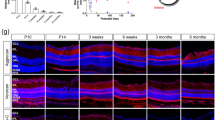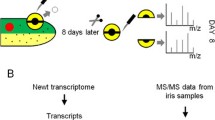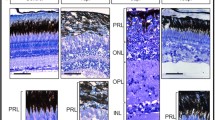Abstract
Retinal degenerative diseases, such as age-related macular degeneration (AMD) and retinitis pigmentosa (RP), are major causes of blindness worldwide. Humans cannot regenerate retina, however, axolotl (Ambystoma mexicanum), a laboratory-bred salamander, can regenerate retinal tissue throughout adulthood. Classic signaling pathways, including fibroblast growth factor (FGF), are involved in axolotl regeneration. Glycosaminoglycan (GAG) interaction with FGF is required for signal transduction in this pathway. GAGs are anionic polysaccharides in extracellular matrix (ECM) that have been implicated in limb and lens regeneration of amphibians, however, GAGs have not been investigated in the context of retinal regeneration. GAG composition is characterized native and decellularized axolotl and porcine retina using liquid chromatography mass spectrometry. Pig was used as a mammalian vertebrate model without the ability to regenerate retina. Chondroitin sulfate (CS) was the main retinal GAG, followed by heparan sulfate (HS), hyaluronic acid, and keratan sulfate in both native and decellularized axolotl and porcine retina. Axolotl retina exhibited a distinctive GAG composition pattern in comparison with porcine retina, including a higher content of hyaluronic acid. In CS, higher levels of 4- and 6- O-sulfation were observed in axolotl retina. The HS composition was greater in decellularized tissues in both axolotl and porcine retina by 7.1% and 15.4%, respectively, and different sulfation patterns were detected in axolotl. Our findings suggest a distinctive GAG composition profile of the axolotl retina set foundation for role of GAGs in homeostatic and regenerative conditions of the axolotl retina and may further our understanding of retinal regenerative models.




Similar content being viewed by others
References
Wong, W.L., Su, X., Li, X., Cheung, C.M., Klein, R., Cheng, C.Y., Wong, T.Y.: Global prevalence of age-related macular degeneration and disease burden projection for 2020 and 2040: a systematic review and meta-analysis. Lancet Glob. Health. 2, e106–e116 (2014)
Barbosa-Sabanero, K., Hoffmann, A., Judge, C., Lightcap, N., Tsonis, P.A., Del Rio-Tsonis, K.: Lens and retina regeneration: new perspectives from model organisms. Biochem. J. 447, 321–334 (2012)
Del Rio-Tsonis, K., Tsonis, P.A.: Eye regeneration at the molecular age. Dev. Dyn. 226, 211–224 (2003)
Haynes, T., Del Rio-Tsonis, K.: Retina repair, stem cells and beyond. Curr. Neurovasc. Res. 1, 231–239 (2004)
Hayashi, T., Mizuno, N., Ueda, Y., Okamoto, M., Kondoh, H.: FGF2 triggers iris-derived lens regeneration in newt eye. Mech. Dev. 121, 519–526 (2004)
Spence, J.R., Aycinena, J.C., Del Rio-Tsonis, K.: Fibroblast growth factor-hedgehog interdependence during retina regeneration. Dev. Dyn. 236, 1161–1174 (2007)
Susaki, K., Chiba, C.: MEK mediates in vitro neural transdifferentiation of the adult newt retinal pigment epithelium cells: is FGF2 an induction factor? Pigment Cell Res. 20, 364–379 (2007)
Spence, J.R., Madhavan, M., Aycinena, J.C., Del Rio-Tsonis, K.: Retina regeneration in the chick embryo is not induced by spontaneous Mitf downregulation but requires FGF/FGFR/MEK/Erk dependent upregulation of Pax6. Mol. Vis. 13, 57–65 (2007)
Schlessinger, J., Plotnikov, A.N., Ibrahimi, O.A., Eliseenkova, A.V., Yeh, B.K., Yayon, A., Linhardt, R.J., Mohammadi, M.: Crystal structure of a ternary FGF-FGFR-heparin complex reveals a dual role for heparin in FGFR binding and dimerization. Mol. Cell. 6, 743–750 (2000)
Sterner, E., Meli, L., Kwon, S.J., Dordick, J.S., Linhardt, R.J.: FGF–FGFR signaling mediated through glycosaminoglycans in microtiter plate and cell-based microarray platforms. Biochemistry. 50, 9009–9019 (2013)
Linhardt, R.J., Toida, T.: Role of glycosaminoglycans in cellular communication. Acc. Chem. Res. 7, 431–438 (2004)
Kim, S.Y., Zhao, J., Liu, X., Fraser, K., Lin, L., Zhang, X., Zhang, F., Dordick, J.S., Linhardt, R.J.: Interaction of Zika virus envelope protein with glycosaminoglycans. Biochemistry. 56, 1151–1162 (2017)
Kim, S.Y., Zhang, F., Gong, W., Chen, K., Xia, K., Liu, F., Gross, R.A., Wang, J.M., Linhardt, R.J., Cotton, M.L.: Copper regulates the interactions of antimicrobial piscidin peptides from fish mast cells with formyl peptide receptors and heparin. J. Biol. Chem. 293, 15381–15396 (2018)
Kaprinis, K., Symeonidis, C., Papakonstantinou, E., Tsinopoulos, I., Dimitrakos, S.A.: Decreased hyaluronan concentration during primary rhegmatogenous retinal detachment. Eur. J. Ophthalmol. 26, 633–638 (2016)
Park, P.J., Shukla, D.: Role of heparan sulfate in ocular diseases. Exp. Eye Res. 110, 1–9 (2013)
McManus, L.M., Mitchell, R.N.: Pathobiology of human disease: a dynamic encyclopedia of disease mechanisms. Elsevier. (2014)
Dreyfuss, J.L., Regatieri, C.V., Lima, M.A., Paredes-Gamero, E.J., Brito, A.S., Chavante, S.F., Belfort Jr., R., Farah, M.E., Nader, H.B.: A heparin mimetic isolated from a marine shrimp suppresses neovascularization. J. Thromb. Haemost. 8, 1828–1837 (2010)
Jiang, X., Couchman, J.R.: Perlecan and tumor angiogenesis. J. Histochem. Cytochem. 51, 1393–1410 (2003)
Regatieri, C.V., Dreyfuss, J.L., Melo, G.B., Lavinsky, D., Hossaka, S.K., Rodrigues, E.B., Farah, M.E., Maia, M., Nader, H.B.: Quantitative evaluation of experimental choroidal neovascularization by confocal scanning laser ophthalmoscopy: fluorescein angiogram parallels heparan sulfate proteoglycan expression. Braz. J. Med. Biol. Res. 43, 627–633 (2010)
Clark, S.J., Bishop, P.N., Day, A.J.: Complement factor H and age-related macular degeneration: the role of glycosaminoglycan recognition in disease pathology. Biochem. Soc. Trans. 38, 1342–1348 (2010)
Clark, S.J., Perveen, R., Hakobyan, S., Morgan, B.P., Sim, R.B., Bishop, P.N., Day, A.J.: Impaired binding of the age-related macular degeneration-associated complement factor H 402H allotype to Bruch’s membrane in human retina. J. Biol. Chem. 285, 192–202 (2010)
Kelly, U., Yu, L., Kumar, P., Ding, J.D., Jiang, H., Hageman, G.S., Arshavsky, V.Y., Frank, M.M., Hauser, M.A., Rickman, C.B.: Heparan sulfate, including that in Bruch’s membrane, inhibits the complement alternative pathway: implications for age-related macular degeneration. J. Immunol. 185, 5486–5494 (2010)
Alibardi, L.: Hyaluronic acid in the tail and limb of amphibians and lizards recreates permissive embryonic conditions for regeneration due to its hygroscopic and immunosuppressive properties. J Exp Zool B Mol Dev Evol. 328, 760–771 (2017)
Ouyang, X., Panetta, N.J., Talbott, M.D., Payumo, A.Y., Halluin, C., Longaker, M.T., Chen, J.K.: Hyaluronic acid synthesis is required for zebrafish tail fin regeneration. PLoS One. 12, e0171898 (2017)
Kulyk, W.M., Zalik, S.E., Dimitrov, E.: Hyaluronic acid production and hyaluronidase activity in the newt iris during lens regeneration. Exp. Cell Res. 172, 180–191 (1987)
Gardiner, D.M.: Regulation of regeneration by heparan sulfate proteoglycans in the extracellular matrix. Regen Eng Transl Med. 3, 192–198 (2017)
Phan, A.Q., Lee, J., Oei, M., Flath, C., Hwe, C., Mariano, R., Vu, T., Shu, C., Dinh, A., Simkin, J., Muneoka, K., Bryant, S.V., Gardiner, D.M.: Positional information in axolotl and mouse limb extracellular matrix is mediated via heparan sulfate and fibroblast growth factor during limb regeneration in the axolotl (Ambystoma mexicanum). Regeneration. 2, 182–201 (2015)
Ramachandra, R., Namburi, R.B., Dupont, S.T., Ortega-Martinez, O., van Kuppevelt, T.H., Lindahl, U., Spillmann, D.: A potential role for chondroitin sulfate/dermatan sulfate in arm regeneration in Amphiura filiformis. Glycobiology. 27, 438–449 (2017)
Becker, C.G, Becker, T.: Repellent guidance of regenerating optic axons by chondroitin sulfate glycosaminoglycans in zebrafish. J. Neurosci. 22, 842–853 (2002)
Rauvala, H., Paveliev, M., Kuja-Panula, J., Kulesskaya, N.: Inhibition and enhancement of neural regeneration by chondroitin sulfate proteoglycans. Neural Regen. Res. 12, 687–691 (2017)
Inatani, M., Tanihara, H.: Proteoglycans in retina. Prog. Retin. Eye Res. 21, 429–447 (2002)
Joven, A., Simon, A.: Homeostatic and regenerative neurogenesis in salamanders. Prog. Neurobiol. 170, 81–98 (2018)
Roy, S., Levesque, M.: Limb regeneration in axolotl: is it superhealing? Sci. World J. 6, 12–25 (2006)
Alunni, A., Bally-Cuif, L.: A comparative view of regenerative neurogenesis in vertebrates. Development. 143, 741–753 (2016)
Sun, Y.B., Xiong, Z.J., Xiang, X.Y., Liu, S.P., Zhou, W.W., Tu, X.L., Zhong, L., Wang, L., Wu, D.D., Zhang, B.L., Zhu, C.L.: Whole-genome sequence of the Tibetan frog Nanorana parkeri and the comparative evolution of tetrapod genomes. Proc. Natl. Acad. Sci. 112, 1257–1262 (2015)
Nowoshilow, S., Schloissnig, S., Fei, J.F., Dahl, A., Pang, A.W., Pippel, M., Winkler, S., Hastie, A.R., Young, G., Roscito, J.G., Falcon, F.: The axolotl genome and the evolution of key tissue formation regulators. Nature. 554, 50–55 (2018)
Svistunov, S.A., Mitashov, V.I.: Proliferative activity of the pigment epithelium and regenerating retinal cells in Ambystoma mexicanum. Ontogenez. 14, 597–606 (1983)
Voss, S.R., Epperlein, H.H., Tanaka, E.M.: Ambystoma mexicanum, the axolotl: a versatile amphibian model for regeneration, development, and evolution studies. Cold Spring Harb Protoc. 8, pdb.emo128, (2009)
Linhardt, R.J., Turnbull, J.E., Wang, H.M., Loganathan, D., Gallagher, J.T.: Examination of the substrate specificity of heparin and heparan sulfate lyases. Biochemistry. 29, 2611–2617 (1990)
Wang, H., He, W., Jiang, P., Yu, Y., Lin, L., Sun, X., Koffas, M., Zhang, F., Linhardt, R.J.: Construction and functional characterization of truncated versions of recombinant keratanase II from Bacillus circulans. Glycoconj. J. 34, 643–649 (2017)
Kundu, J., Michaelson, A., Talbot, K., Baranov, P., Young, M.J., Carrier, R.L.: Decellularized retinal matrix: natural platforms for human retinal progenitor cell culture. Acta Biomater. 31, 61–70 (2016)
Wright, A.F., Chakarova, C.F., El-Aziz, M.M., Bhattacharya, S.S.: Photoreceptor degeneration: genetic and mechanistic dissection of a complex trait. Nat Rev Genet. 11, 273–284 (2010)
Grzybowski, A.: General structure and function of the retina. Acta Ophthalmol. 94, (2016)
Sanchez, I., Martin, R., Ussa, F., Fernandez-Bueno, I.: The parameters of the porcine eyeball. Graefes Arch. Clin. Exp. Ophthalmol. 249, 475–482 (2011)
Porrello, K., Lavail, M.M.: Immunocytochemical localization of chondroitin sulfates in the interphotoreceptor matrix of the normal and dystrophic rat retina. Curr. Eye Res. 5, 981–993 (1986)
Singhal, S., Lawrence, J.M., Bhatia, B., Ellis, J.S., Kwan, A.S., MacNeil, A., Luthert, P.J., Fawcett, J.W., Perez, M.T., Khaw, P.T., Limb, G.A.: Chondroitin sulfate proteoglycans and microglia prevent migration and integration of grafted Müller stem cells into degenerating retina. Stem Cells. 26, 1074–1082 (2008)
Suzuki, T., Akimoto, M., Imai, H., Ueda, Y., Mandai, M., Yoshimura, N., Swaroop, A., Takahashi, M.: Chondroitinase ABC treatment enhances synaptogenesis between transplant and host neurons in model of retinal degeneration. Cell Transplant. 16, 493–503 (2007)
Ichijo, H., Kawabata, I.: Roles of the telencephalic cells and their chondroitin sulfate proteoglycans in delimiting an anterior border of the retinal pathway. J. Neurosci. 21, 9304–9314 (2001)
Brittis, P.A., Canning, D.R., Silver, J.: Chondroitin sulfate as a regulator of neuronal patterning in the retina. Science. 255, 733–736 (1992)
Bakalash, S., Rolls, A., Lider, O., Schwartz, M.: Chondroitin sulfate-derived disaccharide protects retinal cells from elevated intraocular pressure in aged and immunocompromised rats. Invest. Ophthalmol. Vis. Sci. 48, 1181–1190 (2007)
Tate, D.J., Oliver, P.D., Miceli, M.V., Stern, R., Shuster, S., Newsome, D.A.: Age-dependent change in the hyaluronic acid content of the human chorioretinal complex. Arch. Ophthalmol. 111, 963–967 (1993)
Hollyfield, J.G., Rayborn, M.E., Tammi, M., Tammi, R.: Hyaluronan in the interphotoreceptor matrix of the eye: species differences in content, distribution, ligand binding and degradation. Exp. Eye Res. 66, 241–248 (1998)
Inoue, Y., Yoneda, M., Miyaishi, O., Iwaki, M., Zako, M.: Hyaluronan dynamics during retinal development. Brain Res. 1256, 55–60 (2009)
Solursh, M., Vaerewyck, S.A., Reiter, R.S.: Depression by hyaluronic acid of glycosaminoglycan synthesis by cultured chick embryo chondrocytes. Dev. Biol. 41, 233–244 (1974)
Munaim, S.I., Klagsbrun, M., Toole, B.P.: Hyaluronan-dependent pericellular coats of chick embryo limb mesodermal cells: induction by basic fibroblast growth factor. Dev. Biol. 143, 297–302 (1991)
Vatne, H.O., Syrdalen, P.: The use of sodium hyaluronate (Healon) in the treatment of complicated cases of retinal detachment. Acta Ophthalmol. 64(169–172), (1986)
Lipton, S.A., Wagner, J.A., Madison, R.D., D’Amore, P.A.: Acidic fibroblast growth factor enhances regeneration of processes by postnatal mammalian retinal ganglion cells in culture. Proc. Natl. Acad. Sci. U. S. A. 85, 2388–2392 (1988)
Nagy, T., Reh, T.A.: Inhibition of retinal regeneration in larval Rana by an antibody directed against a laminin–heparan sulfate proteoglycan. Brain Res. Dev. 81, 131–134 (1994)
Schubert, D., LaCorbiere, M.: Isolation of a cell-surface receptor for chick neural retina adherons. J. Cell Biol. 100, 56–63 (1985)
Carri, N.G., Perris, R., Johansson, S., Ebendal, T.: Differential outgrowth of retinal neurites on purified extracellular matrix molecules. J. Neurosci. Res. 19, 428–439 (1988)
Chernousov, M.A., Carey, D.J.: N-syndecan (Syndecan 3) from neonatal rat brain binds basic fibroblast growth factor. J. Biol. Chem. 268, 16810–16814 (1993)
Ornitz, D.M., Itoh, N.: The fibroblast growth factor signaling pathway. Wiley Interdiscip. Rev. Dev. Biol. 4, 215–266 (2015)
Keenan, T.D., Pickford, C.E., Holley, R.J., Clark, S.J., Lin, W., Dowsey, A.W., Merry, C.L., Day, A.J., Bishop, P.N.: Age-dependent changes in heparan sulfate in human Bruch's membrane: implications for age-related macular degeneration. Invest. Ophthalmol. Vis. Sci. 55, 5370–5379 (2014)
Acknowledgements
This research was funded by the NIH in the form of grants DK111958, CA231074, HL125371 (to RJL) and by grant NSF-CBET #1606128 (to RLC).
Author information
Authors and Affiliations
Corresponding authors
Ethics declarations
Conflicts of interest
The authors declare to have no conflicts of interest.
Ethical approval
Animals in this study were approved by Institutional Animal Care and Use Committee (IACUC).
Additional information
Publisher’s note
Springer Nature remains neutral with regard to jurisdictional claims in published maps and institutional affiliations.
Rights and permissions
About this article
Cite this article
Kim, S.Y., Kundu, J., Williams, A. et al. Glycosaminoglycans compositional analysis of Urodele axolotl (Ambystoma mexicanum) and Porcine Retina. Glycoconj J 36, 165–174 (2019). https://doi.org/10.1007/s10719-019-09863-5
Received:
Revised:
Accepted:
Published:
Issue Date:
DOI: https://doi.org/10.1007/s10719-019-09863-5




